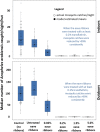Eave ribbons treated with the spatial repellent, transfluthrin, can effectively protect against indoor-biting and outdoor-biting malaria mosquitoes
- PMID: 30333015
- PMCID: PMC6192339
- DOI: 10.1186/s12936-018-2520-1
Eave ribbons treated with the spatial repellent, transfluthrin, can effectively protect against indoor-biting and outdoor-biting malaria mosquitoes
Abstract
Background: Long-lasting insecticide-treated nets and indoor residual spraying protect against indoor-biting and indoor-resting mosquitoes but are largely ineffective for early-biting and outdoor-biting malaria vectors. Complementary tools are, therefore, needed to accelerate control efforts. This paper describes simple hessian ribbons treated with spatial repellents and wrapped around eaves of houses to prevent outdoor-biting and indoor-biting mosquitoes over long periods of time.
Methods: The eave ribbons are 15 cm-wide triple-layered hessian fabrics, in lengths starting 1 m. They can be fitted onto houses using nails, adhesives or Velcro, without completely closing eave-spaces. In 75 experimental nights, untreated ribbons and ribbons treated with 0.02%, 0.2%, 1.5% or 5% transfluthrin emulsion (spatial repellent) were evaluated against blank controls using two experimental huts inside a 202 m2 semi-field chamber where 500 laboratory-reared Anopheles arabiensis were released nightly. Two volunteers sat outdoors (one/hut) and collected mosquitoes attempting to bite them from 6 p.m. to 10 p.m. (outdoor-biting), then went indoors and slept under bed nets, beside which CDC-light traps collected mosquitoes from 10 p.m. to 6.30 a.m. (indoor-biting). To assess survival, 200 caged mosquitoes were suspended near the huts nightly and monitored for 24 h thereafter. Additionally, field tests were done in experimental huts in a rural Tanzanian village to evaluate treated ribbons (1.5% transfluthrin). Here, indoor-biting was assessed using window traps and Prokopack® aspirators, and outdoor-biting assessed using volunteer-occupied double-net traps.
Results: Indoor-biting and outdoor-biting decreased > 99% in huts fitted with eave ribbons having ≥ 0.2% transfluthrin. Even 0.02% transfluthrin-treated ribbons provided 79% protection indoors and 60% outdoors. Untreated ribbons however reduced indoor-biting by only 27% and increased outdoor-biting by 18%, though these were non-significant (P > 0.05). Of all caged mosquitoes exposed near treated huts, 99.5% died within 24 h. In field tests, the ribbons provided 96% protection indoors and 84% outdoors against An. arabiensis, plus 42% protection indoors and 40% outdoors against Anopheles funestus. Current prototypes cost ~ 7USD/hut, are made of widely-available hessian and require no specialized expertise.
Conclusion: Transfluthrin-treated eave ribbons significantly prevented outdoor-biting and indoor-biting malaria vectors and could potentially complement current tools. The technique is simple, low-cost, highly-scalable and easy-to-use; making it suitable even for poorly-constructed houses and low-income groups.
Figures





Similar articles
-
Insecticide-treated eave ribbons for malaria vector control in low-income communities.Malar J. 2021 Oct 23;20(1):415. doi: 10.1186/s12936-021-03945-2. Malar J. 2021. PMID: 34688285 Free PMC article. Review.
-
The efficacy of insecticide-treated window screens and eaves against Anopheles mosquitoes: a scoping review.Malar J. 2021 Sep 29;20(1):388. doi: 10.1186/s12936-021-03920-x. Malar J. 2021. PMID: 34587958 Free PMC article.
-
Eave ribbons treated with transfluthrin can protect both users and non-users against malaria vectors.Malar J. 2019 Sep 18;18(1):314. doi: 10.1186/s12936-019-2958-9. Malar J. 2019. PMID: 31533739 Free PMC article.
-
Evaluation of a push-pull system consisting of transfluthrin-treated eave ribbons and odour-baited traps for control of indoor- and outdoor-biting malaria vectors.Malar J. 2019 Mar 20;18(1):87. doi: 10.1186/s12936-019-2714-1. Malar J. 2019. PMID: 30894185 Free PMC article.
-
Protecting migratory farmers in rural Tanzania using eave ribbons treated with the spatial mosquito repellent, transfluthrin.Malar J. 2019 Dec 10;18(1):414. doi: 10.1186/s12936-019-3048-8. Malar J. 2019. PMID: 31823783 Free PMC article.
Cited by
-
Semi-field evaluation of a novel controlled release device using transfluthrin as spatial repellent to prevent entry of mosquitoes into military tents.Curr Res Parasitol Vector Borne Dis. 2023 Jan 13;3:100113. doi: 10.1016/j.crpvbd.2023.100113. eCollection 2023. Curr Res Parasitol Vector Borne Dis. 2023. PMID: 36793495 Free PMC article.
-
Insecticide-treated eave ribbons for malaria vector control in low-income communities.Malar J. 2021 Oct 23;20(1):415. doi: 10.1186/s12936-021-03945-2. Malar J. 2021. PMID: 34688285 Free PMC article. Review.
-
Creating mosquito-free outdoor spaces using transfluthrin-treated chairs and ribbons.Malar J. 2020 Mar 10;19(1):109. doi: 10.1186/s12936-020-03180-1. Malar J. 2020. PMID: 32156280 Free PMC article.
-
The efficacy of insecticide-treated window screens and eaves against Anopheles mosquitoes: a scoping review.Malar J. 2021 Sep 29;20(1):388. doi: 10.1186/s12936-021-03920-x. Malar J. 2021. PMID: 34587958 Free PMC article.
-
Effect of spatiotemporal variables on abundance, biting activity and parity of Nyssorhynchus darlingi (Diptera: Culicidae) in peri-Iquitos, Peru.Malar J. 2024 Apr 19;23(1):112. doi: 10.1186/s12936-024-04940-z. Malar J. 2024. PMID: 38641572 Free PMC article.
References
MeSH terms
Substances
Grants and funding
LinkOut - more resources
Full Text Sources
Other Literature Sources
Medical
Research Materials

